Elisabeth Bik has been studying publications by the German medical diagnostics company EuroImmun and now questions arise, which the company’s head of marketing however says are ill-informed and false. The concerns about the data integrity are probably out of place since EuroImmun was bought for $1.3 Billion by the US biotech company PerkinElmer in 2017.
Yet why do photographs of EuroImmun’s different virus detection chips show recurrent patterns, among each other and even inside the same chip image, as if someone applied a clone stamp tool in Photoshop? The company’s expert says those photos of assay chips are actually “graphic art”. Maybe but then why do some figures of fluorescence assays contain what looks like duplicated images, resurfacing in a different context? Is it worrisome or rather reassuring that both the company’s now retired founder and German patriot Winfried Stöcker, as well as the new CEO Wolfgang Schlumberger, are listed as key coauthors on papers with such problems? Why is PerkinElmer so silent?
EuroImmun was founded by Stöcker in 1987, the company’s main seat is in Lübeck, northern Germany. The retired CEO now owns a vintage shopping centre in Görlitz, the Lübeck airport, and a marmalade factory. His Wikipedia page contains interesting information about Professor Dr Stöcker’s sociopolitical views:
“On 18 December 2014 Stocker told the Sächsische Zeitung that he wanted to send refugees and foreigners in general “ideally back to their home countries”; they had “no right to settle down in Germany.” [4] Stöcker warned in an interview also against “Islamization” of Germany. […] He insisted to continue using the word “Negro“. […]
In an address to the EuroImmune employees during a Christmas concert in the Church of St. James at the end of 2017, Stöcker spoke critically about the #MeToo movement, feminists and journalists. He also published the speech on his blog. Among other things, he advised “girls” to “dress more restrained and present themselves less provocatively to audition so that poor film directors remain on the path of virtue.” He suspected that it was those in the # MeToo movement who cried out “were optically less favourably endowed by nature”. To the EuroImmun employees, he advised: “(…) conceive many children so that we have something to oppose the wilfully incited mindless onslaught of unauthorised asylum seekers.”

A nice man, this Professor Stöcker, try his marmalade. The University of Lübeck was appalled to have found out their benefactor was concerned about purity of other things than marmalade, and ended the collaboration with EuroImmun. The university however decided to retain Stöcker as adjunct professor without any teaching requirements whatsoever, which allowed him to keep his cherished academic title. Nevertheless, Stöcker retaliated by stopping all financial support to University of Lübeck.
His internationally operating company however remained untainted by any negativity. Some of EuroImmun research is even sponsored by the European Union. In 2016, the company was employing in Germany 1555 and world-wide 2292 people. It even employs graphics designers, experienced with “Adobe InDesign, Illustrator and Photoshop”! Because there is obviously a clear need for illustrative “graphic art”:
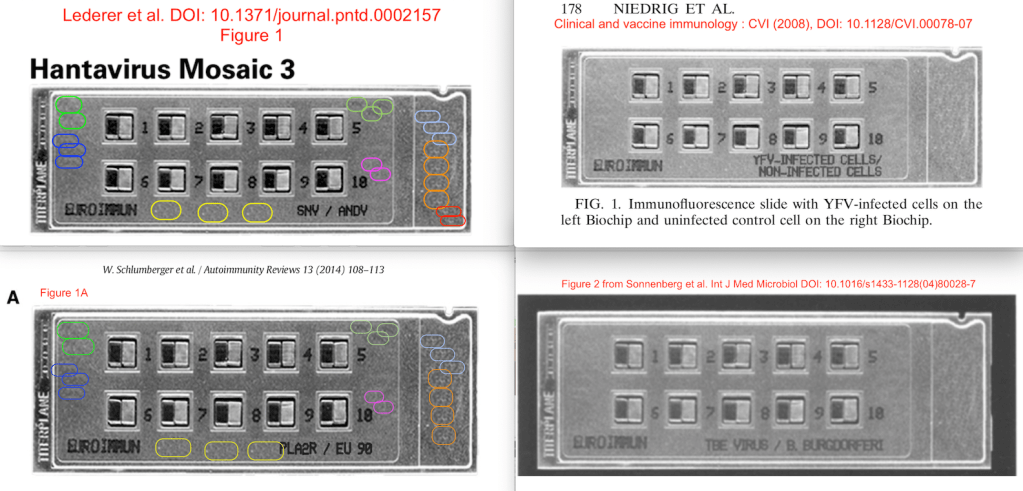
The company is leading expert in “Professional and individual scientific training”, teaching each year over 1000 people from 50 countries in how to do research properly, courses are offered even in Chinese and Spanish. EuroImmun even kind of advertises for their expertise in image integrity online, in product data sheets. Look closely at the two green pictures in the bottom third row:
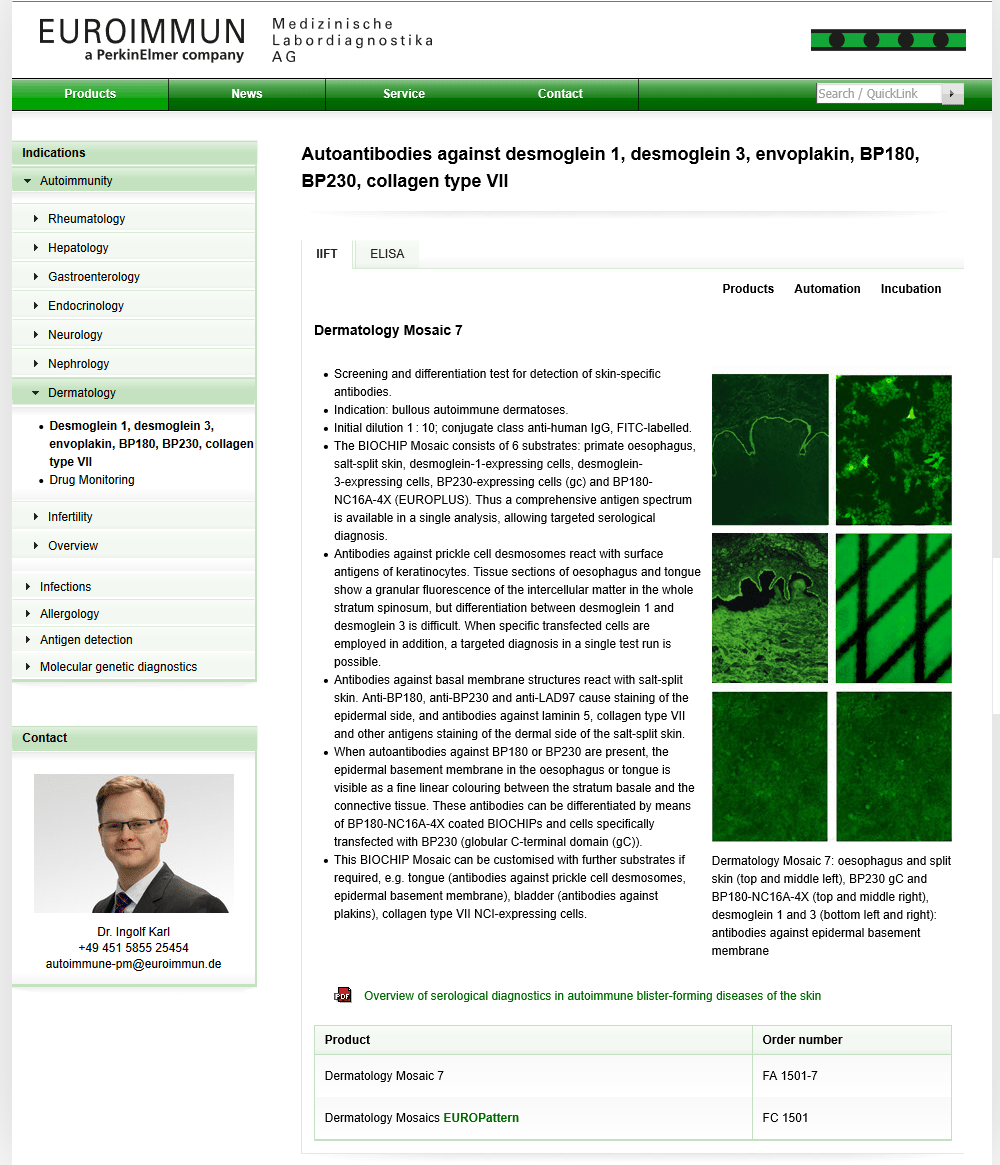
That will definitely reassure every customer about the antibody’s specificity. Which brings us to the main part of this EuroImmun story, the scientific part. The image integrity expert Bik analysed a number of EuroImmun papers, which were often done in collaboration with the University of Lübeck (before Professor Stöcker publicly shared his views on women, foreigners and Muslims, which ended the mutually rewarding financial cooperation). In the time period from 2004 up until now Bik found several papers with puzzling issues. Especially the Euroimmun virus detection chips are a mystery. What happened there,why are the highlighted bits so similar?
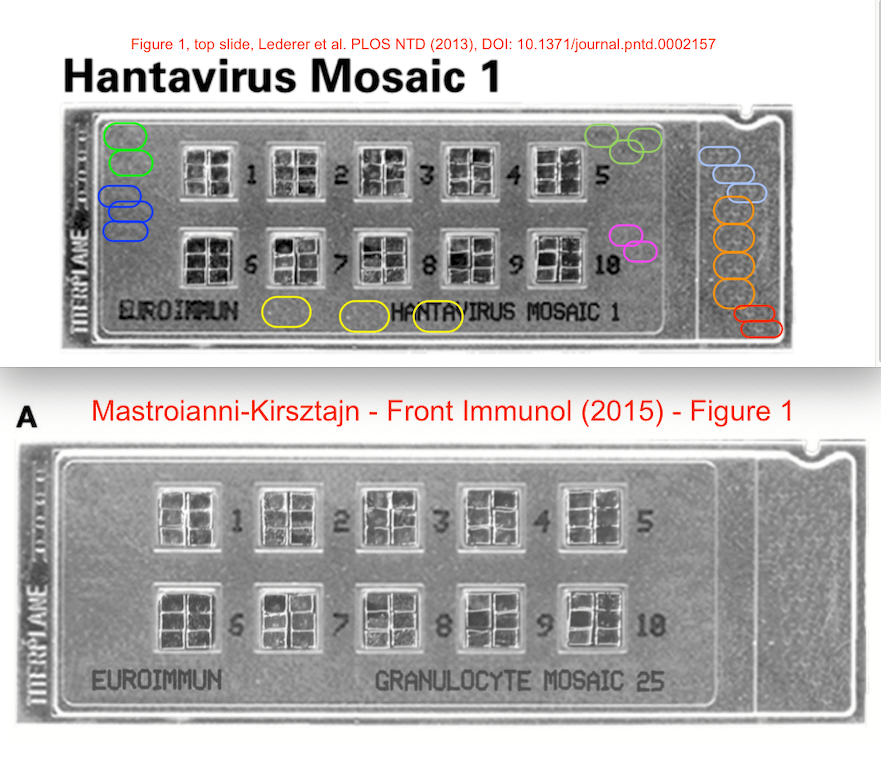
The apparently Photoshopped chip was also presented in the 2010 EuroImmun product catalogue (page 9). It is not clear if this digitally enhanced product is still on offer now, it is not listed in the most recent catalogue. There are also other issues in EuroImmun papers, like this here:
Waltraud Suer, Cornelia Dähnrich, Wolfgang Schlumberger, Winfried Stöcker Autoantibodies in SLE but not in scleroderma react with protein-stripped nucleosomes Journal of Autoimmunity (2004) 10.1016/j.jaut.2004.02.002

Somebody apparently placed a dark rectangle over a part of the last lane, a rather unconventional practice of gel data presentation. Bik observed:
“In the “Nu2 (native)” lane, a completely blank (no background) area appears to be visible in the very relevant “Nucleosomal DNA” area. Image made a bit lighter to bring out the background. Shown with a thin red box.”
Karen Sonnenberg, Matthias Niedrig , Katja Steinhagen , Edda Rohwäder , Wolfgang Meyer , Wolfgang Schlumberger, Ewald Müller-Kunert , Winfried Stöcker State-of-the-art serological techniques for detection of antibodies against tick-borne encephalitis virus Int. J. Med.Microbiol. (2004) doi: 10.1016/s1433-1128(04)80028-7
Bik described the problem, in case EuroImmun and Perkin Elmer struggle to see what and if there might be:
- The top BIOCHIP slide (TBE virus / B. burgdorferi), showing 10 slots with 2 mosaic tiles each bears a striking resemblance to several other EuroImmun slides shown in other papers (DOI: 10.1128/CVI.00078-07, DOI: 10.1371/journal.pntd.0002157, DOI: 10.1016/j.autrev.2013.09.005, DOI: 10.3389/fimmu.2015.00221).
- In particular, Figure’s 2 top slide looks like the bottom slide (Hantavirus Mosaic 3) of Figure 1 of Lederer et al. PLOS NTD (2013), DOI: 10.1371/journal.pntd.0002157. Here is a comparison of the 2 figures with the similar-looking slides marked in aqua boxes.
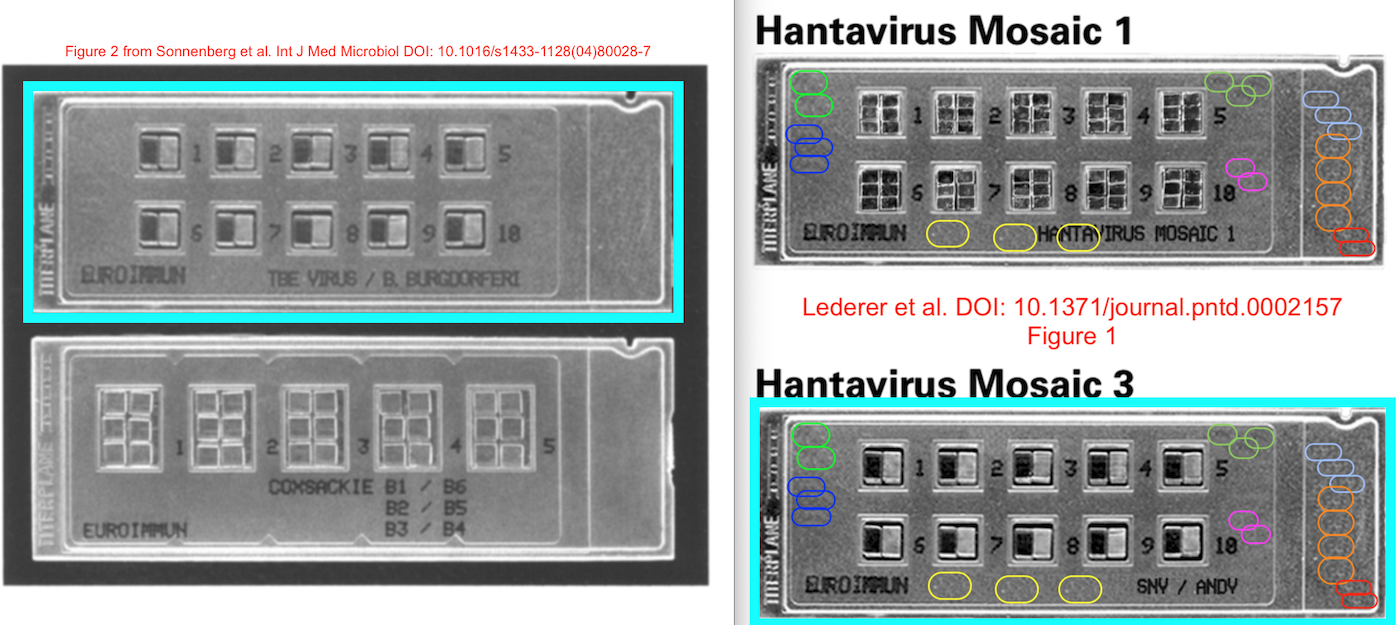
- In addition, these slides appear to show repetitive elements around the center mosaic tiles, as also found in several other papers by this group. These repetitive elements are shown in the Lederer figure above, in thin rounded boxes of the same color.”
It seems EuroImmun’s encephalitis virus detection chip proved surprisingly versatile. This is one of the papers Bik listed, the Yellow Fever Virus (YFV) chip in it share some surprising features:
Matthias Niedrig , Oliver Kursteiner , Christian Herzog , Karen Sonnenberg Evaluation of an Indirect Immunofluorescence Assay for Detection of Immunoglobulin M (IgM) and IgG Antibodies against Yellow Fever Virus Clinical and Vaccine Immunology (2008) doi: 10.1128/CVI.00078-07
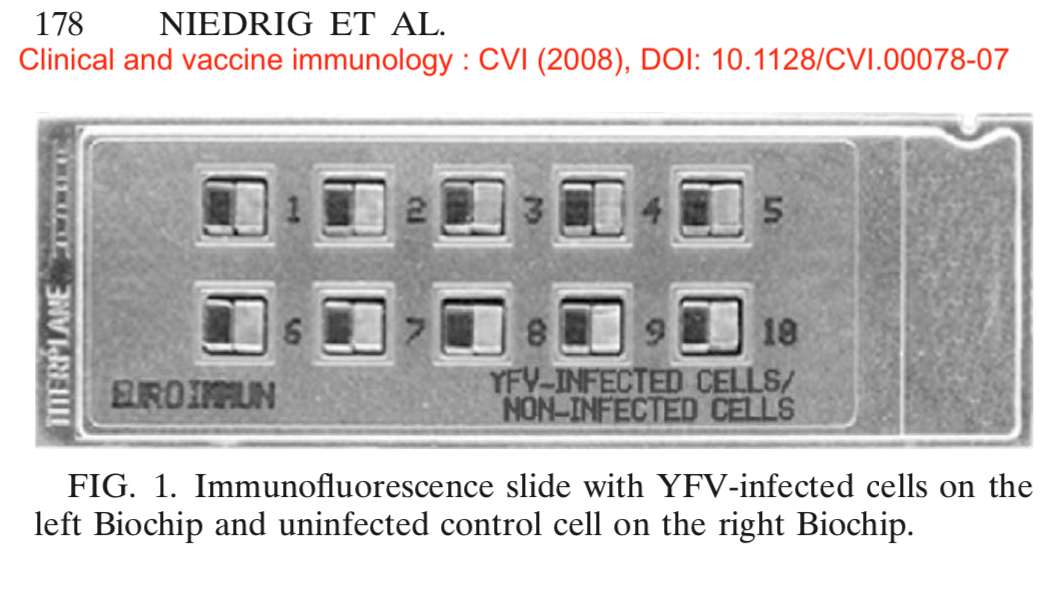
In 2013, a very similar looking chip was used to detect hantavirus. The first author of the 2008 paper became the last author of the 2013 study. It is Matthias Niedrig, former head of the European Network for Imported Viral Diseases and professor at Robert-Koch-Institut, Germany’s top national authority on infectious diseases. If they also think the chips are OK, then who are we to question it.
Sabine Lederer , Erik Lattwein , Merle Hanke , Karen Sonnenberg , Winfried Stoecker , Åke Lundkvist , Antti Vaheri , Olli Vapalahti , Paul K. S. Chan , Heinz Feldmann , Daryl Dick , Jonas Schmidt-Chanasit , Paula Padula , Pablo A. Vial , Raluca Panculescu-Gatej , Cornelia Ceianu , Paul Heyman , Tatjana Avšič-Županc , Matthias Niedrig Indirect Immunofluorescence Assay for the Simultaneous Detection of Antibodies against Clinically Important Old and New World Hantaviruses PLoS Negl Trop Dis (2013) doi: 10.1371/journal.pntd.0002157
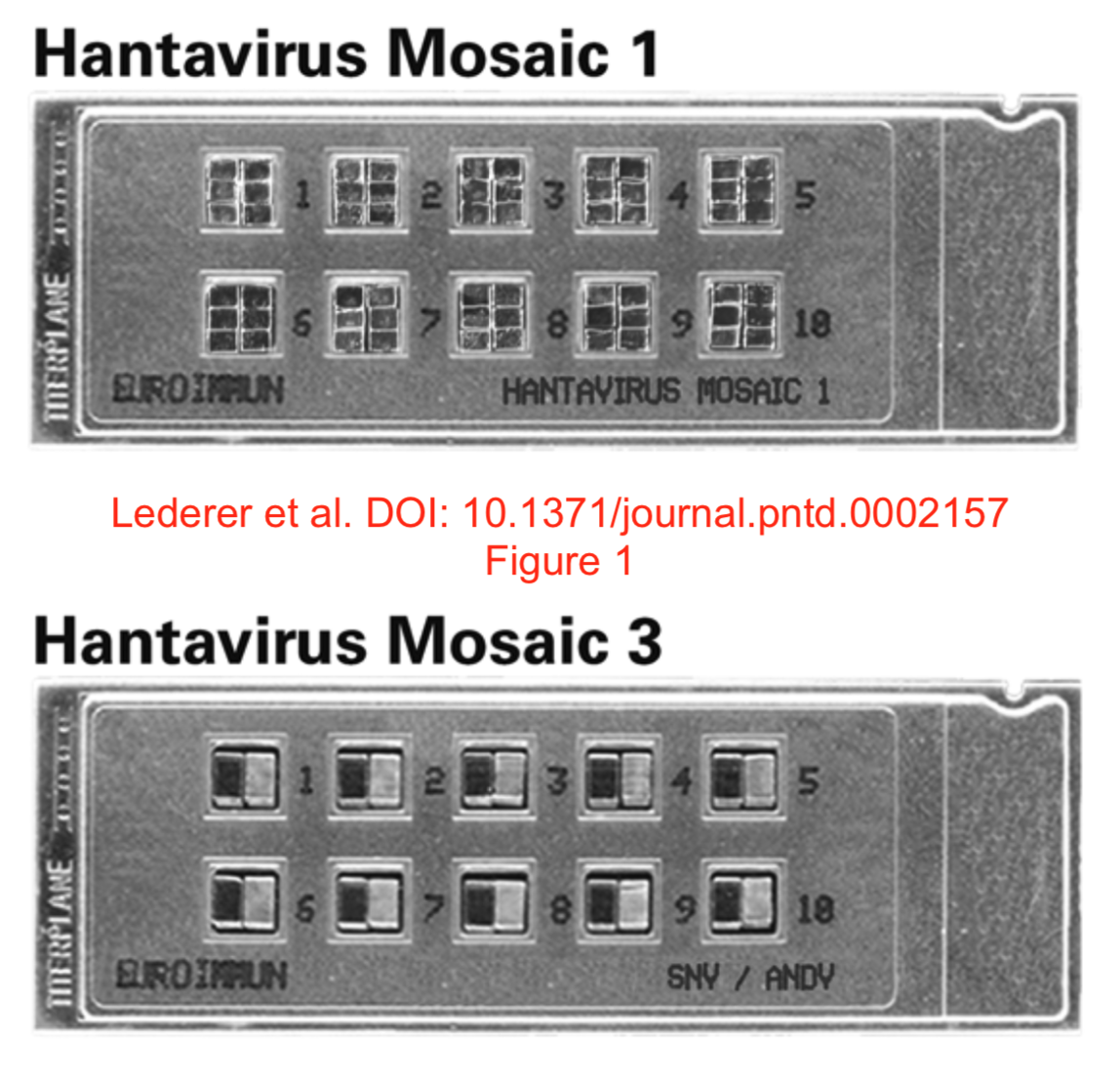
Bik also observed that the chips ” show the same repetitive patterns”. There is a probably some very scientific reason for it, which has to do with the war on neglected tropic diseases in a joint effort between EuroImmun and Robert-Koch-Institute.
In 2014, the chip returned to prance around in a review, authored by both Stöcker and Schlumberger.
Wolfgang Schlumberger, Nora Hornig, Sascha Lange, Christian Probst, Lars Komorowski, Kai Fechner, Cornelia Dähnrich, Winfried Stöcker Differential diagnosis of membranous nephropathy with autoantibodies to phospholipase A2 receptor 1 Autoimmunity Reviews (2014) doi: 10.1016/j.autrev.2013.09.005
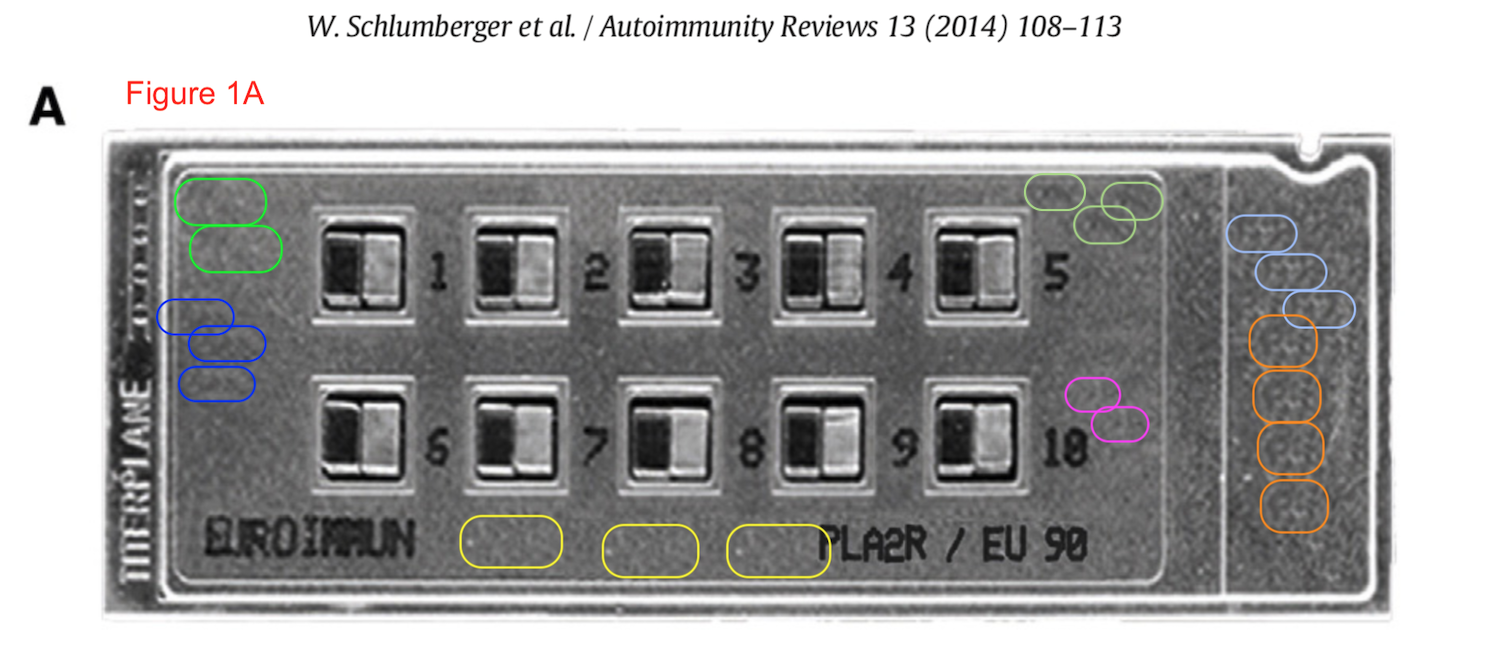
In 2015, the chip finally made it into the world’s bestest journal family, Frontiers.
Gianna Mastroianni-Kirsztajn, Nora Hornig and Wolfgang Schlumberger Autoantibodies in renal diseases – clinical significance and recent developments in serological detection Frontiers in Immunology (2015) doi: 10.3389/fimmu.2015.00221
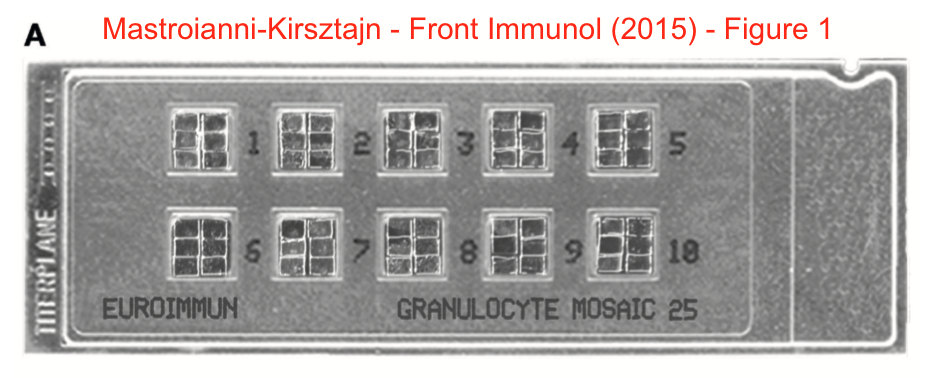
The chip brought even more trouble with it. It turned out, glomerular basement membrane (GBM) and myeloperoxidase (MPO) produce exactly same signal when EuroImmun’s indirect immunofluorescence microdots are deployed. Only rotated.
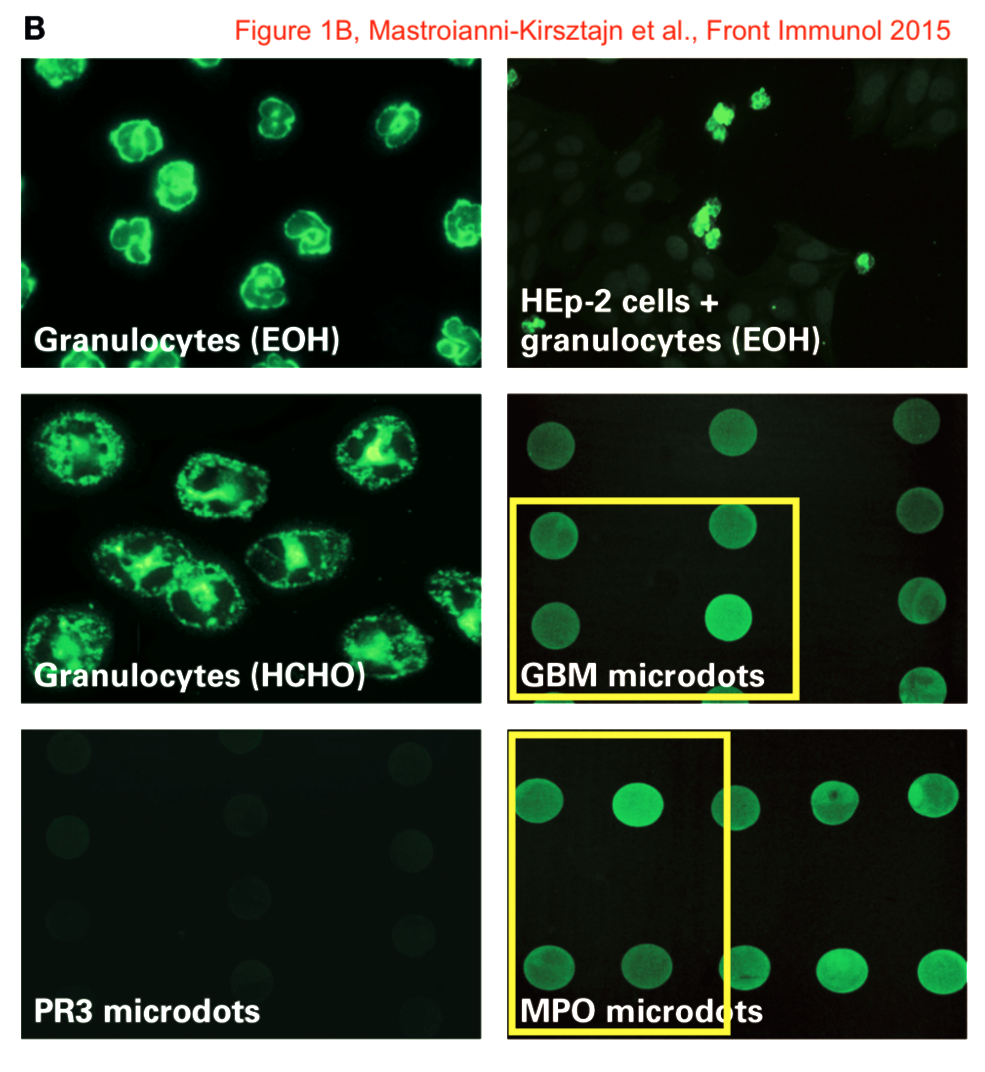
It seems the Photoshop issues extend not to the appearance of the chips, but even to the assays they produce! The next paper featuring Professor Stöcker raises more concerns:
Nina Van Beek , Kristin Rentzsch , Christian Probst , Lars Komorowski , Michael Kasperkiewicz , Kai Fechner , Inga M. Blöcker , Detlef Zillikens , Winfried Stöcker , Enno Schmidt Serological diagnosis of autoimmune bullous skin diseases: Prospective comparison of the BIOCHIP mosaic-based indirect immunofluorescence technique with the conventional multi-step single test strategy Orphanet Journal of Rare Diseases (2012) doi: 10.1186/1750-1172-7-49
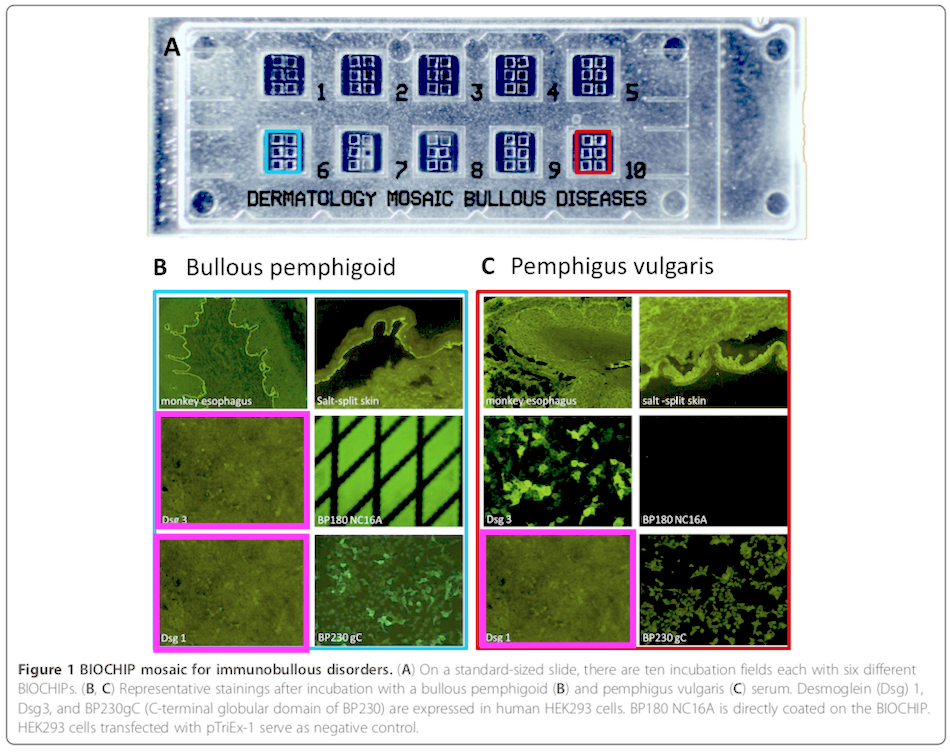
Here the authors highlighted two windows of the chip (Nr 6 and 10), and showed the staining on these in Figure 1B and 1C, respectively. The results are even more reproducible that Euroimmun advertises, because, as Bik writes:
“three of the 12 rectangles look very similar to each other. Shown with bright pink boxes. The teal and red boxes are part of the original figure. Image made lighter to bring out details. Note that the left Dsg 3 panel shows a couple of light spots not visible in the Dsg 1 panels.“
The last sentence should sound alarm bells. This is not how autoimmune skin diseases are supposed to be diagnosed, normally.
The last author Enno Schmidt is professor at, no pun intended of course, LIED. It is the institute for experimental dermatology at the University of Lübeck.
Luckily, another true expert and coauthor arrived to explain what went on with the papers discussed above. Kai Fechner of Euroimmun wrote to me on December 23rd, wishing me happy holidays and educating me about how science is done properly:
“The slides shown in the figures serve to illustrate the biochip technology. The images are therefore more comparable to a graphic art and are not used to collect research data.
The data is collected by incubating slides with serum and then evaluating them in a fluorescence microscope. There is an excitation with blue light and a green fluorescence image is generated, which is then evaluated. Images of slides are therefore completely unsuitable for data collection.
The allegation that results were generated with Photoshop therefore testifies to a lack of knowledge of the matter and is false. I hope that I have contributed to the clarification with my explanations“.
It should be reminded that Fechner is former Head of Quality Management and now Director of International Sales and Marketing at EuroImmun, and as such definitely a much better expert in scientific research and data integrity than Bik can ever strive to become. This was why I asked Fechner’s expert view on the immunofluorescence image duplications such as the one below, but Fechner did not reply again. I presume he is busy talking to other star scientists about important science things, rather than waste his precious time with scientifically illiterate rubes like Bik or myself. Nobody else from Euroimmun or Perkin Elmer replied either.
Hence, what to make of this “graphic art” by Euroimmun?
Christian Probst, Sandra Saschenbrecker, Winfried Stoecker, Lars Komorowski Anti-neuronal autoantibodies: Current diagnostic challenges Multiple Sclerosis and Related Disorders (2014) doi: 10.1016/j.msard.2013.12.001
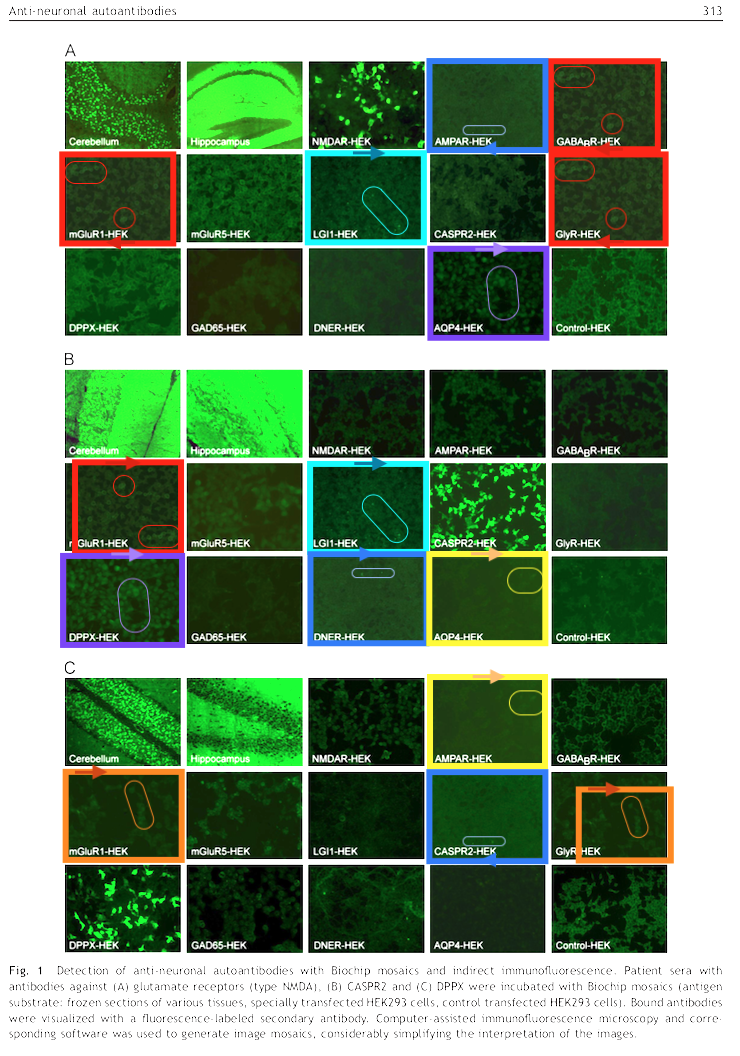
Last author Lars Komorowski is EuroImmun employee, but academically affiliated with the University of Lübeck. I wonder what he would make of this observation by Bik:
“As shown with rectangles of the same color, some of the panels look very similar to each other, albeit sometimes zoomed in differently, or rotated.”
Maybe it is supposed to be this way? A quality sign even, of superiorly advanced and highly reproducible diagnostics technology? Hence the high price of $1.3 billion which PerkinElmer paid for EuroImmun?
Cornelia Dähnrich , Lars Komorowski , Christian Probst , Barbara Seitz-Polski , Vincent Esnault , Jack F. Wetzels , Julia M. Hofstra , Elion Hoxha , Rolf A. Stahl , Gérard Lambeau , Winfried Stöcker , Wolfgang Schlumberger Development of a standardized ELISA for the determination of autoantibodies against human M-type phospholipase A2 receptor in primary membranous nephropathy Clinica Chimica Acta (2013) doi: 10.1016/j.cca.2013.03.015
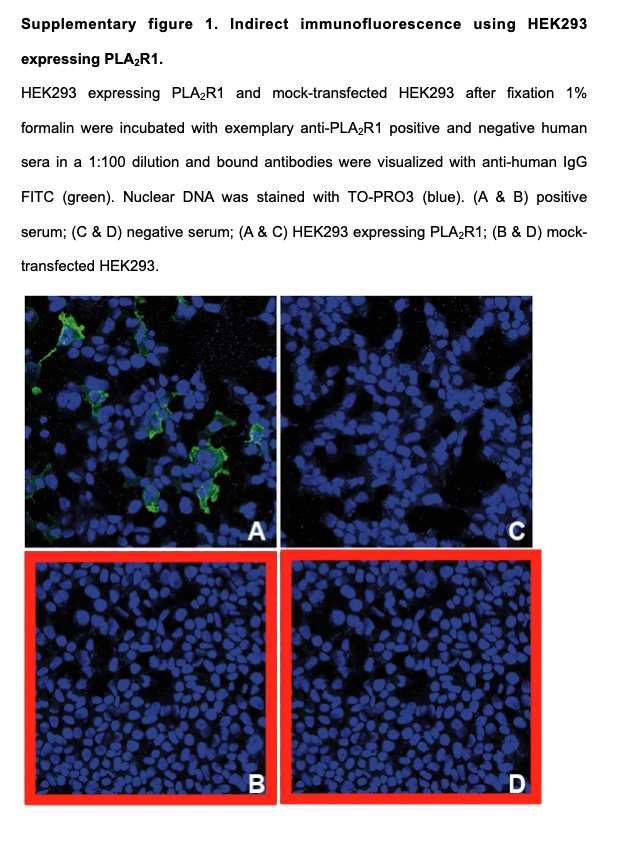
Bik noticed in the Figure S1. that
“Panels B (positive serum on mock transfected HEK293) and D (positive serum on mock transfected HEK293) appear to look very similar.”
Really, this unconventional technology works wonders on autoimmune diseases, no wonder EuroImmun is such a success story…
Georgios Efthymiou, Efthymios Dardiotis, Christos Liaskos, Emmanouela Marou, Vana Tsimourtou, Thomas Scheper, Wolfgang Meyer, Alexandros Daponte, Lazaros I. Sakkas, Georgios Hadjigeorgiou, Dimitrios P. Bogdanos Anti-hsp60 antibody responses based on Helicobacter pylori in patients with multiple sclerosis: (ir)relevance to disease pathogenesis Journal of Neuroimmunology (2016) doi: 10.1016/j.jneuroim.2016.06.009
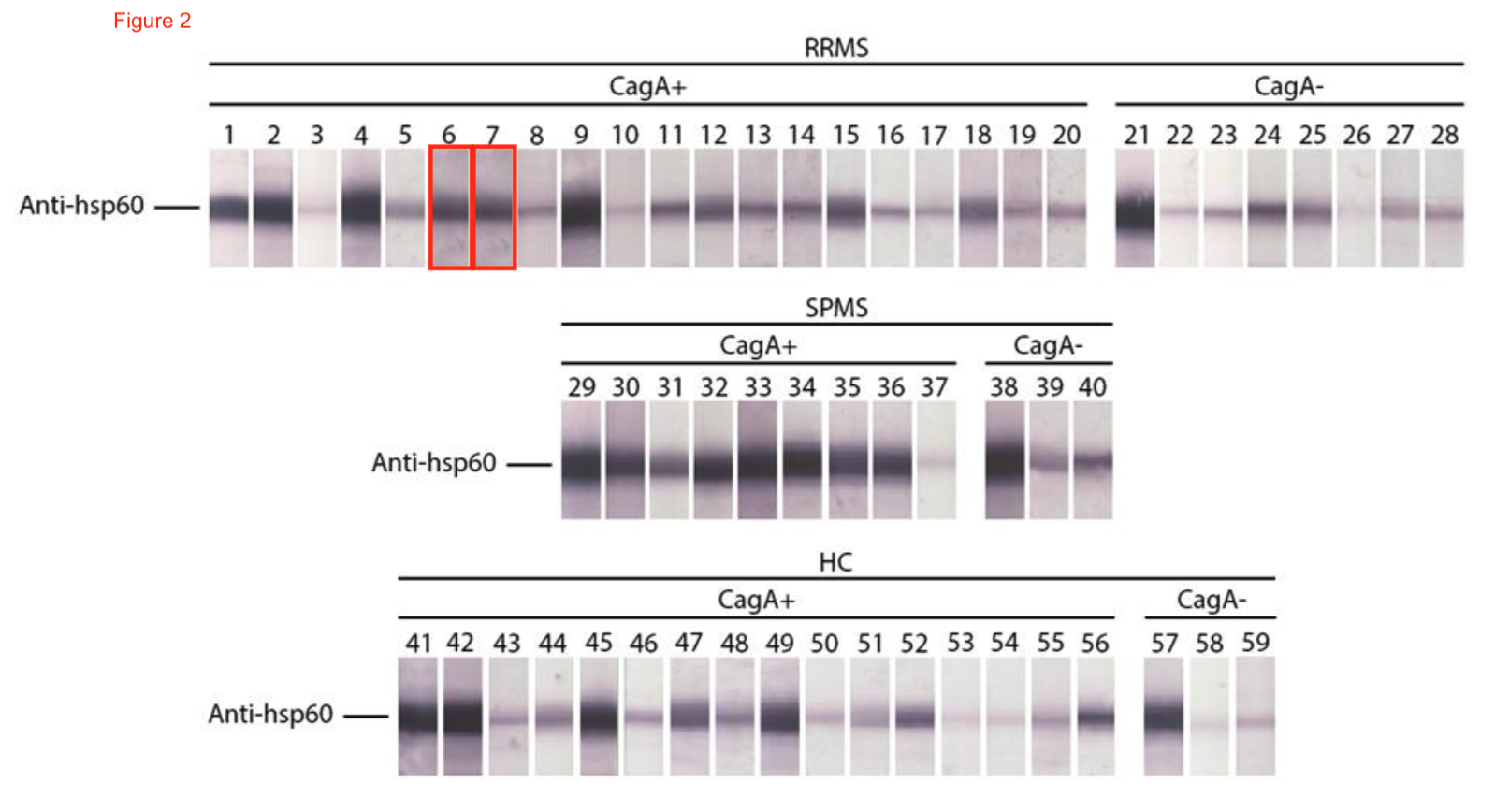
Here, Euroimmun only collaborated, their contributing authors are the two Germans in the middle of the Greek authors list, position 6 and 7. Just like on the gel in Figure 2: Thomas Scheper and Thomas Scheper. Or maybe it was Wolfgang Meyer and Wolfgang Meyer? Pardon the lame joke, very unprofessional of me.
Here another collaboration, with Spanish partners this time:
Amilcar Perez-Riverol , Luís Gustavo Romani Fernandes , Alexis Musacchio Lasa , José Roberto Aparecido Dos Santos-Pinto , Débora Moitinho Abram , Gabriel Hideki Izuka Moraes , Frederic Jabs , Michaela Miehe, Henning Seismman , Mario Sergio Palma , Ricardo De Lima Zollner , Edzard Spillner , Márcia Regina Brochetto-Braga Phospholipase A1-based cross-reactivity among venoms of clinically relevant Hymenoptera from Neotropical and temperate regions Molecular Immunology (2018) doi: 10.1016/j.molimm.2017.11.007
EuroImmun is a German success story, and surely PerkinElmer will be happy to build on its exemplary German-Christian values and its superior attitude to collecting research data.
Disclaimer: The author apologises to EuroImmun and Professor Stöcker for being a non-Christian settled immigrant in Germany.
Update 22.01.2020
Stöcker and Schulmberger provided now a point-by-point reply to the criticisms of Euroimmun papers. Their replies can be read here.

Donate!
If you are interested to support my work, you can leave here a small tip of $5. Or several of small tips, just increase the amount as you like (2x=€10; 5x=€25). Your generous patronage of my journalism will be most appreciated!
€5.00


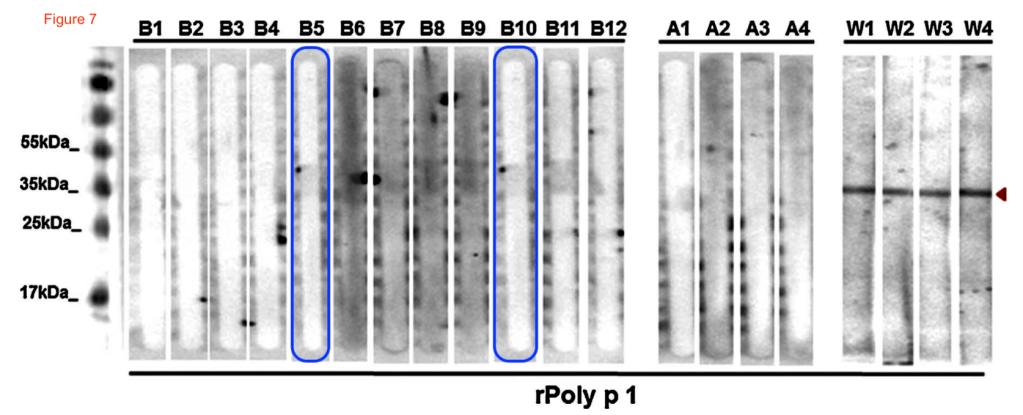

Is there a typo here? “Panels B (positive serum on mock transfected HEK293) and D (positive serum on mock transfected HEK293) appear to look very similar.” (I think D is negative serum)
LikeLiked by 1 person
Yes, sorry for the confusion. This should indeed be D (negative serum…). Thank you for pointing out this error. This error does not affect the conclusions of this PubPeer post 🙂
LikeLiked by 1 person
Once you are a retired CEO, and a journal asks your view about politics, economy, charity sales, etc., you can say whatever you want, since you are now an ordinary pensioner. I do not see a big deal that he has his private opinion about immigration and cultural diversity, and/ or conflicts of cultures. He did not say it as a CEO, so it does not count as a professional act/opinion. Or what do you think? For the image issues: so, maybe I missed one thing here, were these images from a brochure selling the services of the company, or were published in research papers? In the 1st instance it is marketing purpose and well, we all know that the WBs are photoshopped in the catalogues of companies selling antibodies (or are they real WBs? I doubt so.).
LikeLike
Stöcker resigned as CEO in summer 2019. https://www.euroimmunblog.com/a-change-in-the-euroimmun-board/
The duplications discussed are in peer reviewed papers, published mostly in Elsevier.
LikeLike
Anyway, that’s sobering. I always thought of Prof. Ulrich Kutschera as germany’s pathbreaking AfD chief-biologist. Now it turns out that he just mimicked Prof. Stöcker’s genius, who said all relevant things one year before Kutschera did. May be thats the reason why Kassel University and especially their Department of Biology ignore Kutschera so much and keep let him teaching “evolutionary biology”, instead of outsourcing him to EuroImmun/PerkinElmer asap.
LikeLike
Unbelievable! For a company that calls himself “scientific driven”!
LikeLike
Pingback: Euroimmun founder Stöcker: "essential message is beyond any question" – For Better Science
This whole collaboration between the University of Lübeck and Euroimmun is a hoax: Enno Schmidt was holding an endowed professorship funded by Euroimmun. Euroimmun funded most of his research lab. The company has been granting his autoimmune diagnostic lab huge discounts (100%) on diagnostics giving him leverage to outcompete all other diagnostic labs and to generate huge surpluses. He cannot do his research independently as you would expect in academia. This whole story perfectly illustrates what happens when companies buy into small academic institutions. Probably this is what is meant when Euroimmun says it is “scientific driven”.
LikeLike
Pingback: Prof Jean Busquet’s Sauerkraut Therapy – For Better Science
Pingback: German antivaxxers queue for Stöcker vaccine – For Better Science